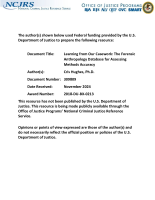Databases
mtGenome Reference Population Databases and the Future of Forensic mtDNA Analysis
Similarity and Clustering of Footwear Prints
Footwear Print Retrieval System for Real Crime Scene Marks
Materials and Products Database - Technical Reference Guide
Forensic Anthropology Skeletal Trauma Database
Subadult Virtual Anthropology Database (SVAD) Data Collection Protocol: Odontometrics
Subadult Virtual Anthropology Database (SVAD) Data Collection Protocol: Dental Morphological Traits
The New Mexico Decedent Image Database
Subadult Virtual Anthropology Database (SVAD) Data Collection Protocol: Epiphyseal Fusion, Diaphyseal Dimensions, Dental Development Stages, Vertebral Neural Canal Dimensions
Third Annual DNA Grantees' Workshop
Postcranial Sex Estimation of Individuals Considered Hispanic
Subadult Virtual Anthropology Database (SVAD) Data Collection Protocol: Cranial Landmarks and Craniometrics
New Orleans Offender Study: Phase 1, Volume 1: Description of Official Record Data and Coding Process
Enhanced Ignitable Liquid and Substrate Database Functionality for Improved Casework and Research
Learning from Our Casework: The Forensic Anthropology Database for Assessing Methods Accuracy
Advancing Justice for the Missing and Unidentified Through Research - 2024 NIJ Research Conference
Forensic science research is developing essential knowledge to fill in the holes in death investigations, creating new ways to identify challenging skeletal remains. These methods inform cause of death, time of death, and familial relationships to guide investigations, identify suspects, support prosecutions, and bring justice to families.
See the YouTube Terms of Service and Google Privacy Policy




